This article was published in Scientific American’s former blog network and reflects the views of the author, not necessarily those of Scientific American
If you read the previous article, you’ll recall my discussing the recent republishing of Dougal Dixon’s SpecZoo classic After Man, originally published in 1981 (and recently republished by Breakdown Press: Dixon 2018). To coincide with the release of this work, several authors have written online articles about SpecZoo: Susannah Lydon wrote one for The Guardian, and Asher Elbein wrote one for Earther. For the latter article, Asher interviewed me, but constraints of space and style meant that he couldn’t include all that much of what I said. With his permission, I here post the full transcript of our discussion, and I hope you find it interesting.
Reminder: after this article, there will only be two more Tet Zoo ver 3 articles and that’s it, I’m shutting up shop. Please consider supporting my writing and research. Ok, here we go…
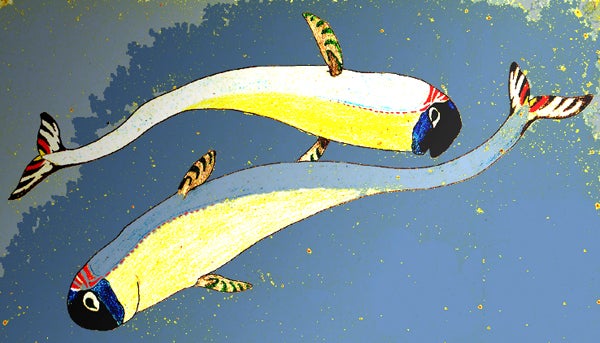
Speculative future delphinoid cetaceans. Make of this what you will. Credit: Darren Naish
On supporting science journalism
If you're enjoying this article, consider supporting our award-winning journalism by subscribing. By purchasing a subscription you are helping to ensure the future of impactful stories about the discoveries and ideas shaping our world today.
Q: What is speculative zoology, and how was it shifted as an artistic and intellectual tradition by After Man? What was After Man’s influence?
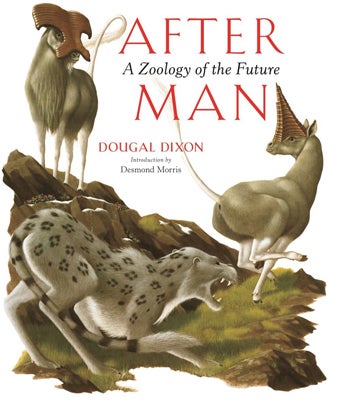
The 2018 Breakdown Press cover of After Man. Credit: Breakdown Press
A: The idea that we might be able to guess or imagine those creatures that could evolve in the future, on other worlds, or in other timelines is a long-standing trope of science fiction, effectively started in 1895 by H. G. Wells for The Time Machine. After Wells, science fiction authors and artists often depicted imaginary products of evolution in the same vein. However, these ideas were generally small in scope: that is, they only involved one or two or three speculative creatures. Edgar Rice Burroughs also worked in a similar tradition across the early decades of the 20th century, but his speculative faunas can also be considered somewhat small.
The significance of After Man is that it was essentially the first grand, large-scale speculative project that involved numerous species – a whole world of species, literally. Furthermore, the whole work is spectacularly illustrated in colour. And it was published by a mainstream publisher and was easily accessible. The idea that entire worlds might be created, and that authors/artists might cover whole pantheons of species, was now on the table. I should give honourable mention to Steiner’s book on snouters – it creates a whole fauna of speculative creatures, but doesn’t illustrate them in lavish colour and has them restricted to a single island archipelago and thus cannot be said to have had the same impact as After Man. Anyway, After Man, I feel, established the idea of world building as goes Speculative Zoology. Things being what they were prior to the age of the internet, I don’t think anybody during the 1980s or early 90s really tried to do what Dougal did and, following After Man’s success, he consolidated his reputation by producing the two follow-up volumes (The New Dinosaurs and the super-creepy Man After Man). Bring things forward to the internet age, and we see several people (and groups of people) effectively doing the exact same thing: copying Dougal’s initial idea.
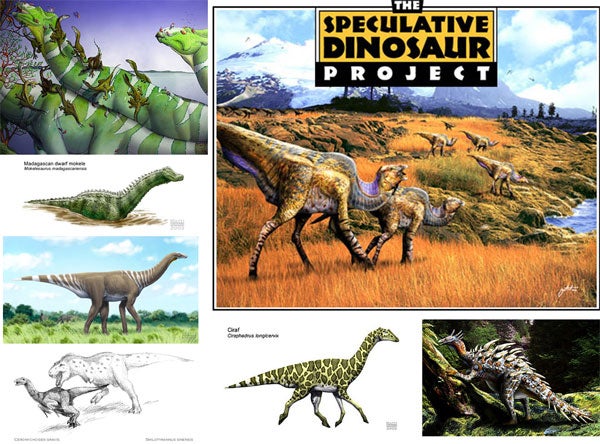
Several major speculative projects have done the grand, world-building thing in the same vein as Dixon: witness the (today mostly abandoned) Speculative Dinosaur Project. Credit: Speculative Dinosaur Project
Q: How have Dixon’s ideas tracked with advances in zoological understanding? Which hold up as possibilities, and which seem less likely?
A: Some of Dougal’s ideas seem prophetic and reasonable in view of more recently acquired knowledge. Aquatic habits in primates, terrestrial bats and the idea that rodents and corvids might be able to give rise to specialised predators are all in accord with recent discoveries. The possibility that grassland-dwelling monkeys could become top predators certainly has a ring of authenticity, especially when we consider the sorry decline of big cats and other carnivorans in the same environments, but the idea that baboons might become theropod-like bipeds looks unlikely given such different anatomical starting points. Furthermore, the idea in After Man that the mammals that have been widely transported around the world by humans – pigs, rabbits and mongooses – might give rise to ecologically significant descendants in places far from their original ancestral homes seems utterly plausible.
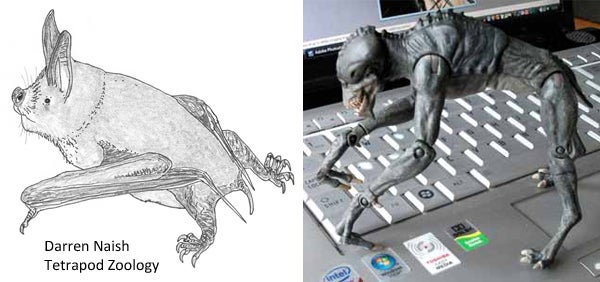
The giant predatory future bat meme starts with Dixon 1981, and is today often linked with the (recently discovered) proficient terrestrial abilities of Real World bats like vampires and mystacinids. This montage shows Mystacina, and a toy of the Primeval Future Predator. Credit: Darren Naish
The giant, filter-feeding penguin of After Man – the Vortex – has been regarded as improbable by some given that there might be little reason for penguins to head that way in evolution, and it and its related cetacean-like relatives might also be deemed unlikely given that we see little evidence that birds are able to transition from egg-laying to viviparity. Then again, this is speculative zoology…
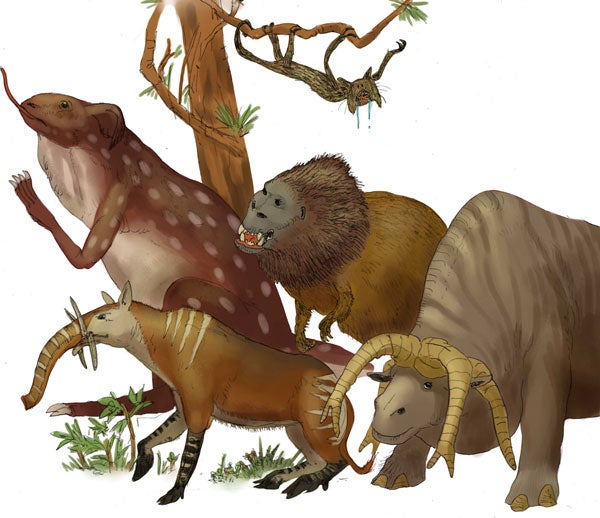
Fan art depicting various of the creatures of After Man. From left to right: Giantala (back), Zarander, Grand raboon (back), Gigantelope; Slobber in the trees. Credit: Darren Naish and Rebecca Groom
And similar things could be said about the flightless bats. The Night stalker is my favourite Dixonian creature, but whether it and its relatives are plausible has been contested by those arguing that bats are seemingly incapable of uncoupling their wing membranes from their limbs. Whatever: I’m glad that Dougal did invent the Night stalker, it’s fabulous.
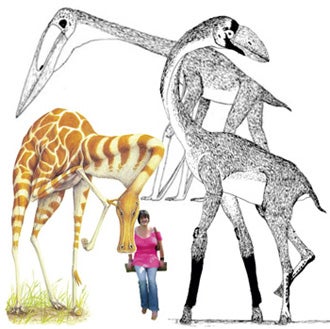
So far, flightless pterosaurs only exist in the world of speculative fiction. Recent work indicates that the Lank of The New Dinosaurs is maybe not all that outlandish after all. Credit: Darren Naish
Q: It seems like Speculative Zoology had a period of mainstream popularity -- I’m thinking about stuff like The Future is Wild and Primeval -- that has since died back a bit. Do you see modern projects around in the style of After Man? There was that French book that never got translated, right?
A: My distinct sense is that Speculative Zoology is like Star Wars (to use a weird analogy). It has a constant, healthy, substantial fanbase, and there might be 10 or 20 or 30 years between movies but … when a new movie appears, things go nuts. There is a constant demand, a long-standing background interest in the subject. So, I don’t think that the fact that TFIW and Primeval aren’t being made right now means anything – they had their run, and that’s that. But other projects have come and gone since and had at least some modicum of success. Examples include Terra Nova (2011), After Earth (2013) (which, despite being a terrible film did not perform all that badly)... and what about Avatar? Avatar is all about Speculative Zoology – and there are a whole series of sequels in production, apparently meaning the franchise will be a constant presence into the 2020s at least.
Q: How do you see the role of speculative zoology? Is it just a fun intellectual game, or can it help us think constructively about ecological possibilities? How should we speculate about the possible effects of anthropogenic factors?
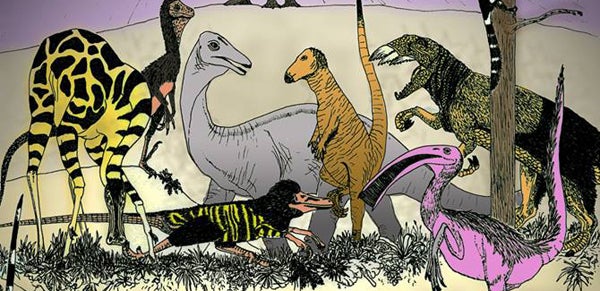
Speculative creatures – like the alt-timeline dinosaurs of The New Dinosaurs – might be educational in that they illustrate real processes via the use of fictional examples. Credit: Darren Naish and Ethan Kocak
A: I certainly agree with Dougal that these projects can be used to illustrate actual processes via the use of fictional examples. An argument could be made that people reading about these speculative creatures could learn from them about trends, processes or events that really have (or do) shape living things. Greenworld - the most recent of Dougal’s projects – is all about environmental collapse, so there’s an eco-environmental message in here as well. But I don’t know if this educational role is really much of a factor – I’d love to know if it is! My thinking is that most people thinking intelligent things while looking at these books are likely already versed in the general principles and processes of biology and ecology. In which case we mustn’t kid ourselves: this stuff is predominantly entertainment. Which is fine.
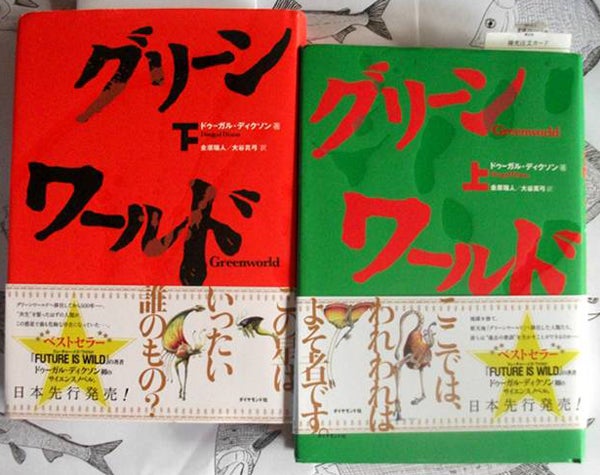
There can’t be too many copies of Dougal Dixon’s two-volume series Greenworld in the UK; I’m the proud owner of these. Fish drawings in the background, for some reason. Credit: Darren Naish
As goes your question about anthropogenic factors – I’d say that we have enough data from fossils, the archaeological record and current events to have a pretty good handle on how humans can influence other living things and their ecosystems. The ‘release’ provided by speculative zoology is that sufficient geological time effectively always allows life to recover.
Q: If I asked you to come up with a world 10 MYA in the future, post anthropocene extinction, do you have a sense of what that would look like? What’s the best-case scenario and worst-case scenario?
A: It’s depressing, but we likely have to start from a place where large organisms are gone and whole groups – conceivably amphibians and most bird and mammal groups except small generalists – are gone. In a best case scenario, enough diversity has persisted across animal groups, and enough habitat patches remain, that a rich assemblage can arise again, the descendants being animals belonging to more than half of those animal groups present today. In a worst-case scenario, the only persisting animals are small generalists of the sort considered pests today, like mice, rats and pigeons. But even they could conceivably give rise to future dynasties, as has been explored in several speculative projects.
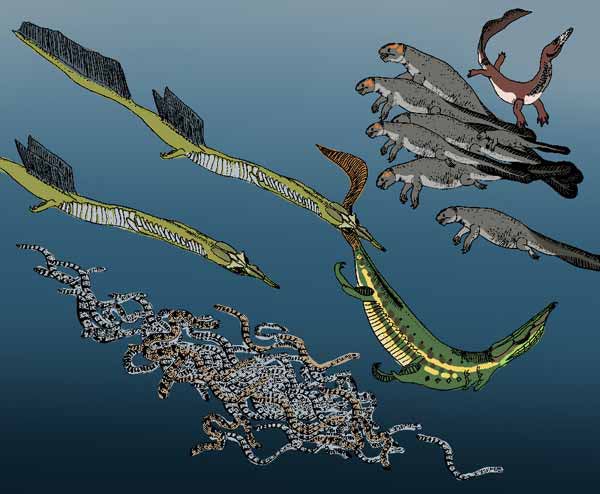
A marine scene from the squamate-dominated world of the Squamozoic, an alt-timeline world devised by a tetrapod-focused blogger. Credit: Darren Naish and Tim Morris
And that is where our discussion ends. For previous Tet Zoo articles on speculative zoology, see…
Oh no, not another giant predatory flightless bat from the future
Of After Man, The New Dinosaurs and Greenworld: an interview with Dougal Dixon
Refs - -
Dixon, D. 2018. After Man: A Zoology of the Future. Breakdown Press, London.